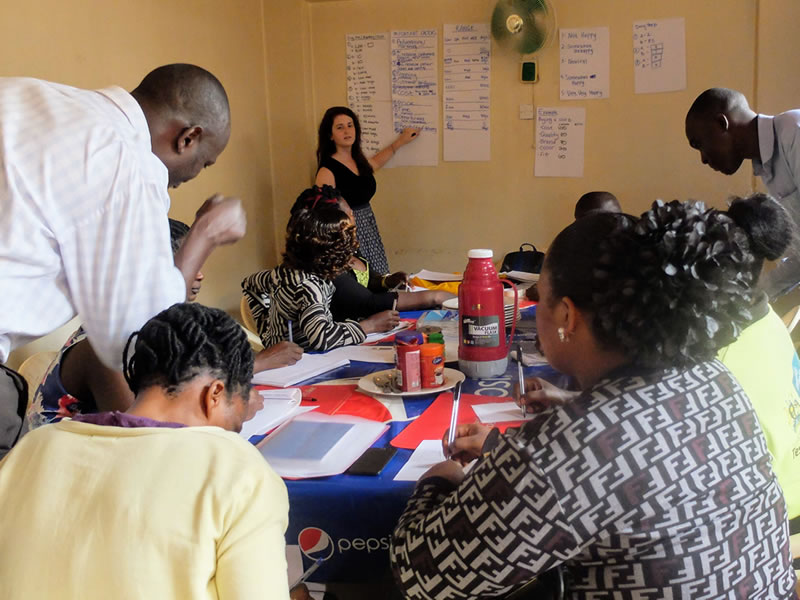
CITE Researcher and MIT Graduate Student Corinne Carland leads a focus group discussion on malaria rapid diagnostic tests.
In Uganda, malaria accounts for 34 percent of all outpatient visits and 37 percent of all hospital admissions. All-cause under-five mortality dropped 53 percent between 2006 and 2016, largely because of successful efforts to scale up vector-control interventions, but progress on scaling up rapid diagnosis and correct treatment of malaria cases lags behind. Even today, malaria diagnoses are often based solely on clinical symptoms, particularly among persons seeking care in the private sector. Those patients do not undergo diagnostic testing with a malaria rapid diagnostic test (mRDT) or microscopy to confirm that they do in fact have malaria.
Surveys of private-sector outlets in a number of malaria-affected countries in sub-Saharan Africa indicate that mRDTs are rarely available or used for malaria diagnosis. To better understand the supply-side factors that may explain this market failure, PMI collaborated with USAID’s Global Development Lab and its implementing partners from MIT’s Comprehensive Initiative on Technology Evaluation (CITE), and the Malaria Consortium in Uganda to study factors that influence buyers’, distributors’, and retailers’ decision to stock mRDTs.
The research was conducted via the Global Development Lab-funded Higher Education Solutions Network. The Malaria Consortium, which was conducting an UNITAID-funded pilot study to introduce mRDTs into the private sector in Uganda, collaborated on the design and data collection of the study. PMI provided technical guidance and oversight, and facilitated linkages with MIT, the Malaria Consortium, and the Uganda National Malaria Control Program. Working together, PMI, the Global Development Lab, the Malaria Consortium, and MIT’s Humanitarian Supply Chain Lab, which led this CITE project, opened the door for improvements in the private-sector supply chain for mRDTs that will be essential to improve the diagnosis and treatment of malaria in Uganda.
MIT researchers worked closely with the Malaria Consortium to conducted interviews and focus groups with buyers, distributors, and retailers involved to increase the availability of mRDTs in Uganda’s private sector. The researchers used multi-attribute value analysis to quantify the objectives and priorities of agents at various levels of the supply chain. Results indicated that buyers who had similar roles in the supply chain had differing preferences, which may be important to consider when designing interventions. One agent valued nongovernmental relationships and administrative time, but did not want to invest more than 10 hours per week in managing mRDTs. In contrast, another buyer focused on profits and sales of other products and was willing to spend more time in achieving these financial results.
Researchers found that retailers and buyers liked the Malaria Consortium pilot—which combined a product subsidy with a bundle of services including training for retailers, advertising, barcoding, and biohazard disposal. Distributors were less satisfied because they carried the burden of expired stock as retailers placed small orders. Future initiatives should consider the risk structure across the supply chain.
The research also pointed to the potential of a different business model. Retailers were most concerned about the time spent on each transaction, which is a consultative sales process. It takes as many as 60 minutes to explain the importance of accurate diagnosis, administer the mRDT, wait for the results, and then provide appropriate treatment. However, retailers were interested in providing diagnostic services, as their highest-weighted criterion in the analysis was training on how to properly administer the devices.
These results suggest that mRDTs could be promoted as part of a “malaria service” provided by retailers, instead of offered as a product with a simple sales transaction. This service could cover both diagnosis and treatment (with an antimalarial or appropriate alternative, depending on the test result). And if the alternate treatment is low cost, then the malaria service could be priced lower than antimalarial treatment alone.
The research has been published in the European Journal of Operational Research and was recently selected as a finalist for the Decision Analysis Practice Award, which is given at the annual meeting for the Institute for Operations Research and Management Sciences. For a detailed summary of the research, visit MIT’s website.

